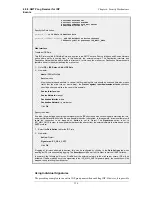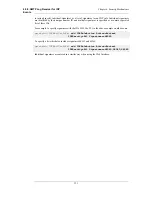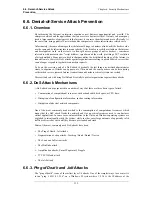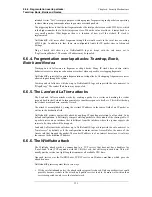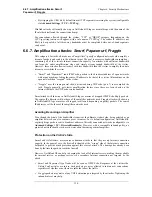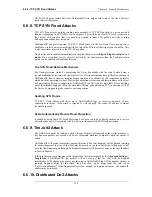
Web Interface
1.
Go to Rules > IP Rules > Add > IPRule
2.
Specify a suitable name for the rule, for example NAT_HTTP
3.
Now enter:
•
Action: NAT
•
Service: http
•
Source Interface: lan
•
Source Network: lannet
•
Destination Interface: any
•
Destination Network: all-nets
4.
Under the NAT tab, make sure that the Use Interface Address option is selected
5.
Click OK
Protocols Handled by NAT
Dynamic address translation is able to deal with the TCP, UDP and ICMP protocols with a good
level of functionality since the algorithm knows which values can be adjusted to become unique in
the three protocols. For other IP level protocols, unique connections are identified by their sender
addresses, destination addresses and protocol numbers.
This means that:
•
An internal machine can communicate with several external servers using the same IP protocol.
•
An internal machine can communicate with several external servers using different IP protocols.
•
Several internal machines can communicate with different external servers using the same IP
protocol.
•
Several internal machines can communicate with the same server using different IP protocols.
•
Several internal machines can not communicate with the same external server using the same IP
protocol.
Note: Restrictions only apply to IP level protocols
These restrictions apply only to IP level protocols other than TCP, UDP and ICMP,
such as OSPF and L2TP. They do not apply to the protocols transported by TCP, UDP
and ICMP such as telnet, FTP, HTTP and SMTP.
NetDefendOS can alter port number information in the TCP and UDP headers to
make each connection unique, even though such connections have had their sender
addresses translated to the same IP.
Some protocols, regardless of the method of transportation used, can cause problems during address
translation.
Anonymizing Internet Traffic with NAT
A useful application of the NAT feature in NetDefendOS is for anonymizing service providers to
7.2. NAT
Chapter 7. Address Translation
344
Summary of Contents for DFL-1600 - Security Appliance
Page 27: ...1 3 NetDefendOS State Engine Packet Flow Chapter 1 NetDefendOS Overview 27 ...
Page 79: ...2 7 3 Restore to Factory Defaults Chapter 2 Management and Maintenance 79 ...
Page 146: ...3 9 DNS Chapter 3 Fundamentals 146 ...
Page 227: ...4 7 5 Advanced Settings for Transparent Mode Chapter 4 Routing 227 ...
Page 241: ...5 4 IP Pools Chapter 5 DHCP Services 241 ...
Page 339: ...6 7 Blacklisting Hosts and Networks Chapter 6 Security Mechanisms 339 ...
Page 360: ...7 4 7 SAT and FwdFast Rules Chapter 7 Address Translation 360 ...
Page 382: ...8 3 Customizing HTML Pages Chapter 8 User Authentication 382 ...
Page 386: ... The TLS ALG 9 1 5 The TLS Alternative for VPN Chapter 9 VPN 386 ...
Page 439: ...Figure 9 3 PPTP Client Usage 9 5 4 PPTP L2TP Clients Chapter 9 VPN 439 ...
Page 450: ...9 7 6 Specific Symptoms Chapter 9 VPN 450 ...
Page 488: ...10 4 6 Setting Up SLB_SAT Rules Chapter 10 Traffic Management 488 ...
Page 503: ...11 6 HA Advanced Settings Chapter 11 High Availability 503 ...
Page 510: ...12 3 5 Limitations Chapter 12 ZoneDefense 510 ...
Page 533: ...13 9 Miscellaneous Settings Chapter 13 Advanced Settings 533 ...

